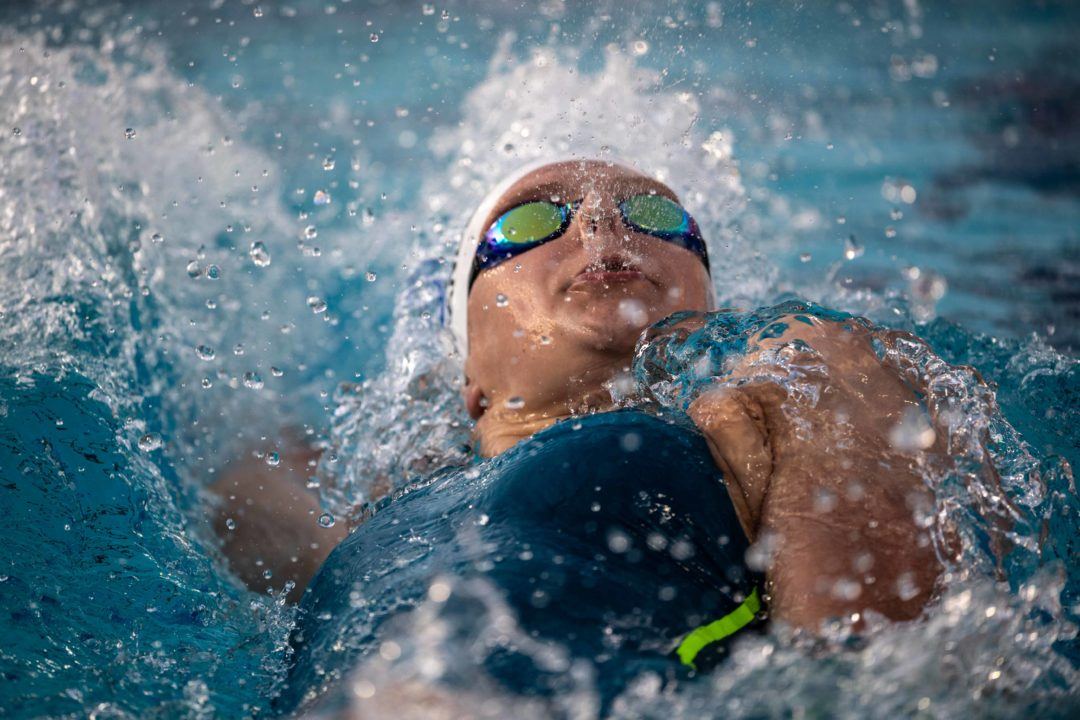Courtesy of Gary Hall Sr., 10-time World Record Holder, 3-time Olympian, 1976 Olympic Games US Flagbearer and The Race Club co-founder.
The head position in backstroke should change throughout the stroke cycle. There are two reasons most swimmers are more comfortable swimming backstroke with their heads held too high, a position I often refer to as ‘reading in bed’. First, a backstroker with the head held high has more awareness of where he/she is in the lane. Slamming into a lane line can be a disastrous and painful complication of swimming backstroke, so holding the head up high helps to avoid that problem. Second, swimmers are more powerful in the ‘sitting up’ position than they are when the head is back, so they can generate more propulsion.
The real problem with swimming backstroke with the head held too high is from the increase in frontal drag caused from this position. When the head elevates, the hips and legs sink. Not only does the swimmer increase surface drag with the head up and out of the water, but also pressure drag, by not keeping the body horizontal. In swimming, frontal drag forces are so powerful, even at relatively slow speeds, that the increase in propulsion from keeping the head elevated is not enough to overcome the additional frontal drag. While laying the head back may lessen the frontal drag, keeping the head back all the time is not a good idea, either. The truth is that in backstroke, you can have your cake and eat it, too.
Head back for less drag
The key to a successful backstroke is getting the head up at the right time and getting it back at the right time. It doesn’t need to move far in either direction, but it does need to move. Like in freestyle, at the fastest point in the stroke cycle, the surge point, the head should lay back so the drag is lowered. Unlike freestyle, we actually get to see the bow wave pass over our face, since our eyes are now looking upward. The surge point in backstroke should occur just after one hand enters the water, timed with the surge kick. At that moment, a slight trickle of water should pass over the surface of the swimmer’s face (goggles). Being just millimeters under water at that important point is enough to reduce drag considerably.
Head up for more power
Once the hand begins the generate propulsion on its way backward, the head needs to elevate to put the swimmer in a more favorable biomechanical position of strength. The swimmer also needs to elevate the head for the breath. This is a more powerful position.
Backstrokers need both
Most swimmers are good at elevating their heads because they like to know where they (and their competitors) are in the lane and race. They also like the feeling of more power that comes from that position. What they are not good at is getting the head back for the surge point. With each stroke cycle, the head should elevate slightly during the propulsion phase and lay back for the surge point. In effect, the swimmer should do a mini-crunch while swimming backstroke all the way down the pool.
At fast stroke rates, which is a good idea in backstroke, the swimmer may not have time to get the head up and back down for each arm pull. Doing so once per stroke cycle, rather than twice, becomes necessary. For example, the swimmer may come up with the head for a breath on the left arm recovery and lay the head back once the right hand strikes the water.
Since getting the head back far enough seems to be the biggest challenge in backstroke, this week we share one of our favorite drills for accomplishing this goal. You can check it out in Lanes 2, 3, or 4 on our website.

Gary Hall, Sr., Technical Director and Head Coach of The Race Club (courtesy of TRC)
Yours in swimming,
Gary Sr.
Like The Race Club on Facebook
Follow The Race Club on Instagram
Follow The Race Club on Twitter
Connect to The Race Club / Gary Hall Sr. on Linkedin
THE RACE CLUB
 Because Life is Worth Swimming, our mission is to promote swimming through sport, lifelong enjoyment, and good health benefits. Our objective is for each member of and each participant in The Race Club to improve his or her swimming performances, health, and self-esteem through our educational programs, services and creativity. We strive to help each member of The Race Club overcome challenges and reach his or her individual life goals.
Because Life is Worth Swimming, our mission is to promote swimming through sport, lifelong enjoyment, and good health benefits. Our objective is for each member of and each participant in The Race Club to improve his or her swimming performances, health, and self-esteem through our educational programs, services and creativity. We strive to help each member of The Race Club overcome challenges and reach his or her individual life goals.
The Race Club provides facilities, coaching, training, technical instruction, video, fitness and health programs for swimmers of all ages and abilities. Race Club swim camps are designed and tailored to satisfy each swimmer’s needs, whether one is trying to reach the Olympic Games or simply improve one’s fitness. Our programs are suitable for beginner swimmers, pleasure swimmers, fitness swimmers, USA swimming or YMCA swimmers, or triathletes; anyone who wants to improve swimming skills. All of our Race Club members share an enjoyment of being in the water and use swimming to stimulate a more active mind and body.
Swim training is courtesy of The Race Club, a SwimSwam partner.
